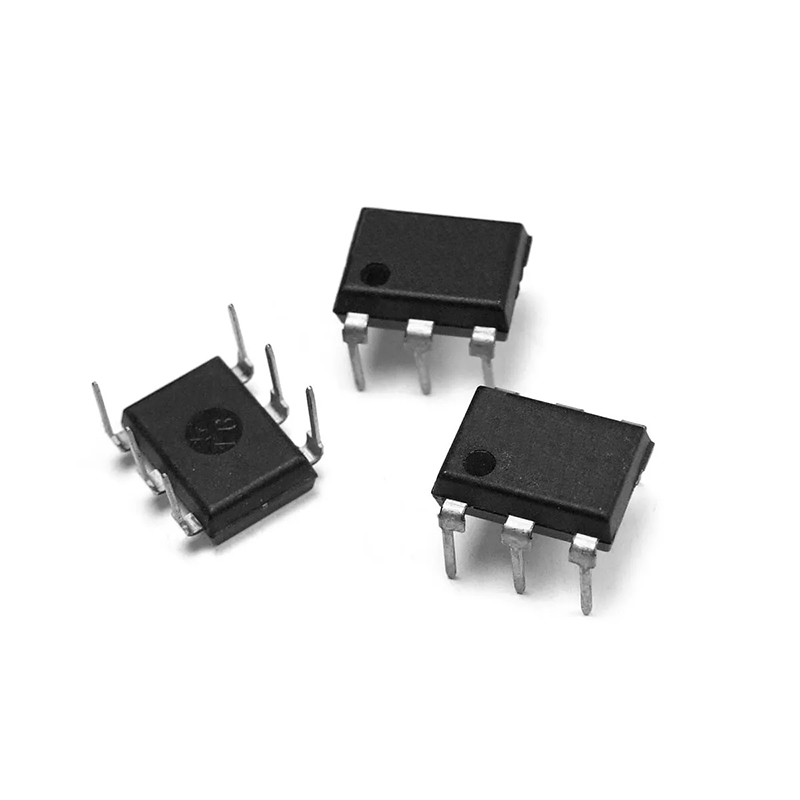Optocouplers play a pivotal role in modern electronics, providing essential electrical isolation and signal transmission capabilities across various circuits and systems. Among these, the 4N25 and 4N35 optocouplers stand out as key components in the optocoupler family, each offering distinct features and applications. Understanding the differences and nuances between these devices is crucial for engineers and designers seeking optimal solutions for their specific requirements.
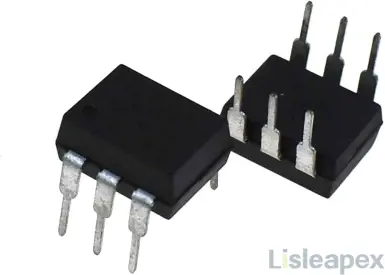
In this comprehensive comparison, we delve into the fundamental characteristics, functionalities, and application scenarios of the 4N25 and 4N35, aiding in informed decision-making and efficient utilization of these essential electronic components.
What is 4N25
The 4N25 is a prominent member of the optocoupler family, alongside similar counterparts like the 4N26, 4N27, and 4N28. These optocouplers share identical functionalities and pin diagrams. Each device comprises a photodiode and a phototransistor. The infrared light-emitting diode is crafted from gallium arsenide material, while the phototransistor is constructed from monolithic silicon material.

The coupling between the photodiode and phototransistor is designed such that when infrared light emitted by the photodiode reaches the base pin of the phototransistor, it triggers the transistor to conduct, establishing an electrical connection akin to a closed switch between the collector and emitter pins. This mechanism enables efficient signal transmission and electrical isolation between two circuits, enhancing the versatility and reliability of the 4N25 and its counterparts in various electronic applications.
4N25 Pinout
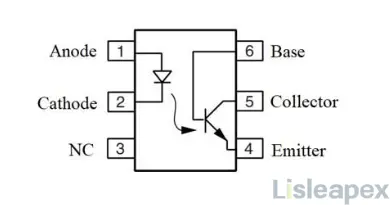
The 4N25, along with its counterparts 4N26, 4N27, and 4N28, belongs to a series of optocouplers commonly used in electronic circuits for isolation and signal transmission purposes. These devices consist of an LED (Light Emitting Diode) optically coupled to a phototransistor. Below is the pinout description for the 4N25 optocoupler:
|
Pin |
Function |
|
Anode (1) |
Anode terminal of LED |
|
Cathode (2) |
Cathode terminal of LED |
|
NC (3) |
No connection / Not used |
|
Emitter (4) |
Emitter pin of phototransistor |
|
Collector (5) |
Collector pin of phototransistor |
|
Base (6) |
Base pin of phototransistor |
The Anode (1) and Cathode (2) are terminals of the LED inside the optocoupler. The Emitter (4), Collector (5), and Base (6) pins correspond to the phototransistor inside. Pin 3 is not connected and remains unused in the circuit. This pinout configuration is consistent across the 4N25 series optocouplers.
2D Model
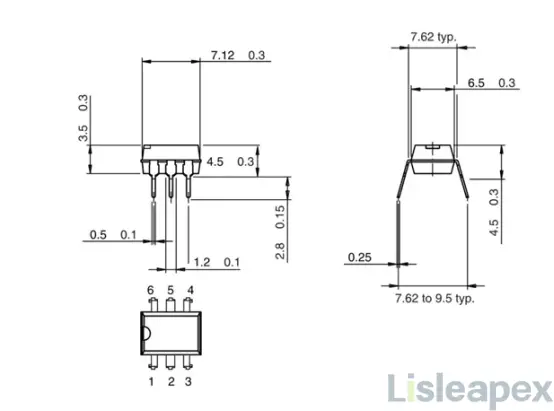
4N25 Features
- High Voltage Isolation: Offers a test voltage of 500Vrms, ensuring robust electrical isolation between input and output circuits.
- Compact Design: Housed in a common 6-pin DIP package, facilitating easy integration into various electronic circuits.
- Fast Switching Time: Demonstrates very fast switching with minimal rise and fall times, enhancing overall system response.
- Low Coupling Capacitance: Maintains a coupling capacitance of less than 0.5 pF between the input and output sides, minimizing signal distortion.
- Input Side Specifications: Supports a reverse voltage of 5 volts and forward current of 60mA, ensuring reliable operation.
- High Power Dissipation: The infrared photodiode can dissipate up to 100mW of power, enhancing durability.
- Robust Voltage Ratings: Features a collector-emitter voltage breakdown of 70V and an emitter-base breakdown voltage of 7V, ensuring stability under varying conditions.
- Output Side Power Handling: Capable of dissipating up to 150mW of power on the output side, ensuring reliability.
- Extensive Testing: Tested up to 5000 Vrms isolation voltage, ensuring adherence to stringent safety standards.
- Minimal Switching Period Times: Exhibits a rise time and fall time of 2μs each, facilitating rapid signal switching.
- No External Biasing Required: Eliminates the need for external biasing power supply, simplifying circuit design and reducing component count.
4N25 Application
AC Mains Detection: The 4N25 optoisolator is employed to detect the presence of AC mains voltage. When mains voltage is detected, the microcontroller initializes the system.
Overload Protection: A current sensor continuously monitors the load current. If the current exceeds a predefined threshold indicating overload, the microcontroller activates the relay via the 4N25 optoisolator to disconnect the power supply, preventing damage to the connected devices.
Remote Control: The WiFi module enables remote control of the power outlet. Users can remotely turn the outlet on or off using a smartphone application or a web interface.
Reed Relay Driving: The 4N25 drives a reed relay, enabling reliable switching of the power outlet based on commands received from the microcontroller.
Switch Mode Power Supply Feedback: Feedback signals from the power outlet are provided to the microcontroller via the 4N25, allowing it to monitor the outlet status and adjust operation accordingly.
Logic Ground Isolation: Isolation between different circuit grounds is ensured by the 4N25, preventing ground loops and ensuring stable operation.
Logic Coupling with High-Frequency Noise Rejection: The 4N25 effectively couples logic signals between the microcontroller and relay while rejecting high-frequency noise, ensuring accurate and reliable control signals.
4N25 Circuit
The 4N25 optocoupler is employed in a straightforward circuit for controlling an LED optically via a switch. In this setup, a logic switch generates a high or low signal directed to the input side of the 4N25. The photodiode within the optocoupler responds to this signal, activating or deactivating the phototransistor accordingly. Consequently, the LED connected to the output side illuminates or remains off, depending on the state of the logic switch. This configuration showcases the optocoupler's capacity for electrical isolation and signal transmission between distinct voltage domains, enhancing system safety and reliability.
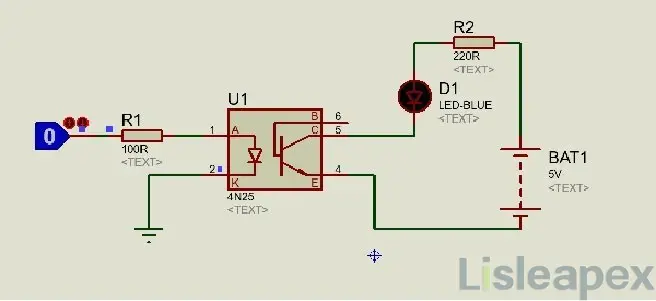
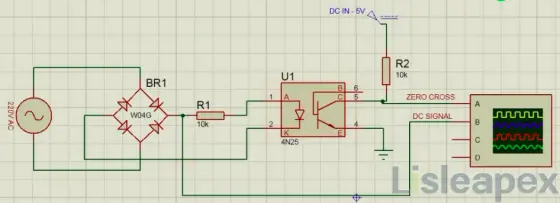
Package Dimensions
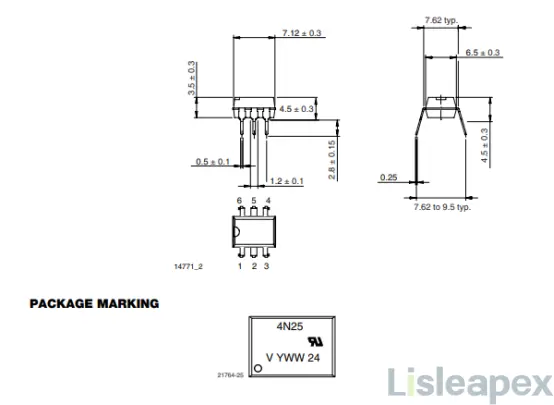
4N25 Datasheet PDF
Download 4N25 Datasheet PDF >>
What is 4N35
The 4N35 optocoupler is a widely employed device designed to ensure electrical isolation and signal transmission between different circuits. Featuring a gallium arsenide infrared emitting diode coupled with a silicon phototransistor, it comes in a 6-pin DIP package, offering versatility for various applications. With a fast response time of 3 µs and a minimum current transfer ratio (CTR) of 100% at 10 mA input current, the 4N35 is prized for its reliability and suitability across a spectrum of tasks, including AC power detection, reed relay driving, and logic ground isolation.
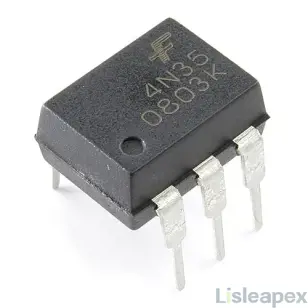
How to Use 4N35
Using the 4N35 Optocoupler is a simple process, as it consists of an infrared light-emitting diode (IRLED) and a phototransistor, each serving distinct purposes. Connect the anode pin of the LED to the output terminal of the device under operation, such as an integrated circuit or microcontroller, and connect the cathode pin of the LED to the device's ground terminal. It's essential to incorporate a current-limiting resistor in series with the LED, similar to standard LED connections.
Upon activation of the device's output signal, the LED emits infrared light. This emitted light is detected by the phototransistor, causing it to conduct or illuminate. Consequently, a connection is established between the collector and emitter pins, creating a pathway for current flow between these two terminals (typically pins 4 and 5). It's worth noting that the internal phototransistor operates akin to a conventional bipolar junction transistor (BJT) and is controllable. Additionally, linking pin 6 to the transistor's base enables precise control over its operational state.
4N35 Pinout
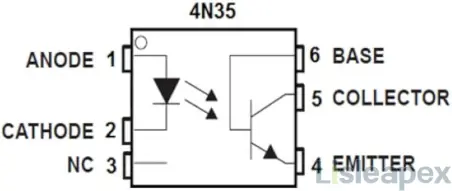
The 4N35 optocoupler features a six-pin configuration, serving as a critical component for electrical isolation and signal transmission in electronic circuits. The device comprises an IR LED and a phototransistor, allowing for seamless coupling between input and output circuits. Pin 3 remains unconnected in the circuit. The following table outlines the pinout and functions of the 4N35 optocoupler:
|
Pin |
Function |
|
1 |
Anode: IR LED anode/positive terminal |
|
2 |
Cathode: IR LED cathode/negative terminal |
|
3 |
NC (Not Connected): Unused pin |
|
4 |
Base: Base terminal of the phototransistor |
|
5 |
Collector: Collector terminal of the phototransistor |
|
6 |
Emitter: Emitter terminal of the phototransistor |
4N35 Specifications
|
Parameter |
Value |
|
Manufacturer |
Lite-On |
|
Package / Case |
PDIP-6 |
|
Packaging |
Tube |
|
Mounting Style |
Through Hole |
|
Number of Channels |
1 Channel |
|
Operating Temperature |
-55°C to 100°C |
|
Rise/Fall Time |
10 us |
|
Isolation Voltage |
3550 Vrms |
|
Forward Current (If) |
60 mA |
|
Reverse Voltage (VR) |
6 V |
|
Forward Voltage (Vf) |
1.5 V |
|
Power Dissipation |
350 mW |
|
Product Category |
Transistor Output Optocouplers |
Features of 4N35
- Electrical Isolation: Provides reliable electrical isolation between input and output circuits, preventing voltage spikes and potential damage.
- Phototransistor Output: Equipped with a phototransistor output for efficient signal transmission and noise immunity in various electronic applications.
- High Isolation Voltage: Boasts a high isolation voltage of 3550 Vrms, ensuring robust insulation between input and output channels.
- Fast Rise/Fall Time: Features a fast rise/fall time of 10 microseconds, facilitating rapid switching and response in time-sensitive applications.
- Low Power Consumption: Consumes minimal power, with a low forward current (If) of 60 mA and a power dissipation of 350 mW, ensuring energy efficiency.
- Compact PDIP-6 Package: Housed in a compact PDIP-6 package, enabling easy integration into various circuit designs and space-constrained applications.
Application of 4N35
AC Power Detection: With its electrical isolation capability, the 4N35 optocoupler accurately detects AC power levels in electronic devices and systems, ensuring safe and reliable operation even in high-voltage environments.
Reed Relay Drive: Leveraging the 4N35's efficient signal transmission, it precisely drives reed relays, facilitating dependable switching actions crucial in industrial automation and automotive applications where reliability is paramount.
Switch Mode Power Supply Feedback: By facilitating feedback signal transmission, the 4N35 enables precise regulation of output voltage in switch mode power supplies, enhancing efficiency and stability in power management systems.
Phone Ring Detection: In telecommunication systems, the 4N35 detects phone ring signals effectively, enabling timely call management and communication, vital for seamless connectivity in telecommunications networks.
Logic Ground Isolation: Implementing the 4N35 ensures robust isolation of logic grounds, crucial in mixed-signal circuits, to prevent ground loops and maintain signal integrity, especially in complex electronic systems requiring precise data transmission.
4N35 Equivalent Part
The 4N35 optocoupler, while renowned for its versatile applications, has several equivalents in the optocoupler family, including LOC110, PC816, 4N36, 4N25, and 6N1136. These alternatives offer similar functionalities and performance characteristics, making them suitable replacements for specific applications where the 4N35 may not be readily available or optimized.
The LOC110 is a viable alternative to the 4N35, offering comparable electrical isolation and signal transmission capabilities. With similar pin configurations and performance characteristics, the LOC110 serves as a reliable substitute in various electronic circuits and systems requiring optocoupler functionality.
PC816:
The PC816 shares common features with the 4N35, providing efficient electrical isolation and signal transfer between input and output circuits. Its compatibility and performance make it a suitable alternative for applications where the 4N35 is unavailable or unsuitable.
4N36:
Like the 4N35, the 4N36 optocoupler offers reliable electrical isolation and signal transmission. With similar specifications and pin configurations, the 4N36 serves as a viable replacement for the 4N35 in various electronic designs and systems.
4N25:
The 4N25, while belonging to the same optocoupler family, serves as an equivalent to the 4N35 in many applications. With comparable performance characteristics and functionalities, the 4N25 provides an alternative option for designers seeking optocouplers with similar capabilities.
6N1136:
The 6N1136 optocoupler, similar to the 4N35, offers reliable electrical isolation and signal transmission in electronic circuits. With compatible pin configurations and performance specifications, the 6N1136 serves as a suitable substitute for the 4N35 in various applications.
Package Dimensions
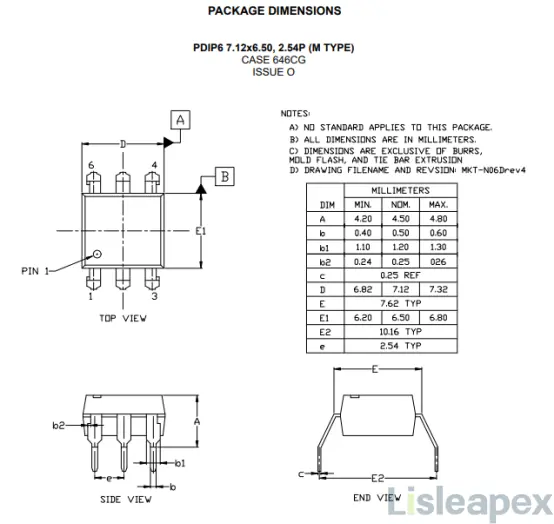
4N35 Datasheet
Download 4N35 Datasheet PDF here>>
4N25 vs 4N35: What are Differences
Although both the 4N25 and 4N35 optocouplers belong to the same family and serve similar purposes, they exhibit several differences in terms of specifications and applications. While the 4N25 offers specific features like faster response time and higher collector-emitter voltage breakdown, the 4N35 excels in areas such as higher forward current and a lower rise/fall time.
|
Feature |
4N25 |
4N35 |
|
Response Time |
Typically 3 µs |
Fast response time of 3 µs |
|
Collector-Emitter Voltage |
70V |
Not specified |
|
Forward Current (If) |
60mA |
Not specified |
|
Rise/Fall Time |
Not specified |
10 µs |
|
Isolation Voltage |
5000 Vrms |
3550 Vrms |
|
Package Type |
DIP-6 |
PDIP-6 |
|
Application Range |
AC power detection, logic coupling, etc. |
AC power detection, reed relay drive, etc. |
4N25 vs 4N35: How to Choose between 4N25 and 4N35
When faced with the choice between the 4N25 and 4N35 optocouplers, several factors come into play to determine the most suitable option for your application. Firstly, considering the response time, both devices offer commendable performance, with the 4N35 boasting a slightly faster response time of 3 µs compared to the 4N25's typical 3 µs. However, for applications where rapid signal transmission and response are critical, both options provide similar performance in this regard.
Moving on to isolation voltage, the 4N25 provides a higher isolation voltage of 5000 Vrms compared to the 4N35's 3550 Vrms. If your application requires robust electrical isolation between input and output circuits, opting for the 4N25 ensures adequate isolation to meet or exceed your requirements.
Additionally, considering forward current specifications, the 4N25 supports a forward current of 60mA, while specific forward current ratings for the 4N35 are not provided. If your application demands a specific forward current rating, the 4N25 may be the preferred choice unless the 4N35 meets your current requirements.
Furthermore, package type plays a crucial role in compatibility with your circuit layout and assembly requirements. The 4N25 comes in a DIP-6 package, while the 4N35 is housed in a PDIP-6 package. Ensuring compatibility with your assembly process and circuit layout is essential when making your selection.
Lastly, considering the application range, both optocouplers are versatile and suitable for various tasks, including AC power detection, logic coupling, and ground isolation. However, the 4N35 is specifically suited for applications such as AC power detection, reed relay driving, and switch mode power feedback. Therefore, choosing the optocoupler that aligns best with the specific requirements and functionalities of your application is crucial for optimal performance and compatibility.
Conclusion
In conclusion, the choice between the 4N25 and 4N35 optocouplers hinges on a multitude of factors, including response time, isolation voltage, forward current, and package type, among others. While both devices excel in providing electrical isolation and signal transmission, their specific specifications and application ranges cater to different needs and scenarios.
Engineers and designers must carefully evaluate their project requirements and performance criteria to select the most suitable optocoupler for optimal system performance and reliability. With their robust features and versatile applications, the 4N25 and 4N35 continue to serve as indispensable components in a wide array of electronic designs, ensuring efficient and reliable operation across diverse industries and applications.
FAQ
-
What are the main differences between the 4N25 and 4N35 optocouplers?
The 4N25 and 4N35 optocouplers differ mainly in their maximum isolation voltages, current transfer ratios, and package types. The 4N25 typically has a lower maximum isolation voltage and current transfer ratio compared to the 4N35. Additionally, they may come in different package types such as through-hole or surface mount.
-
Which optocoupler is better for high-speed applications?
The 4N25 is generally better suited for low to moderate-speed applications due to its lower maximum isolation voltage and current transfer ratio. On the other hand, the 4N35 may be more suitable for high-speed applications due to its higher current transfer ratio and potentially higher isolation voltage.
-
Which optocoupler is more commonly used in industrial applications?
Both the 4N25 and 4N35 optocouplers are commonly used in industrial applications for signal isolation, level shifting, and noise suppression. The choice between them depends on factors such as speed requirements, isolation voltage, and cost considerations.
-
Do the 4N25 and 4N35 optocouplers require external components for operation?
Yes, both optocouplers typically require external components such as resistors and capacitors for proper operation. These components are used to bias the LED and control the output characteristics of the phototransistor.
-
Which optocoupler is more cost-effective?
The cost-effectiveness of the 4N25 vs. the 4N35 may vary depending on factors such as production volume, supplier pricing, and specific application requirements. Generally, the 4N25 may be more cost-effective for applications that do not require high-speed operation or high isolation voltages.
-
Can the 4N25 and 4N35 optocouplers be used interchangeably in the same circuit?
In many cases, the 4N25 and 4N35 optocouplers can be used interchangeably in the same circuit with minor adjustments to component values or circuit configuration. However, differences in specifications such as maximum isolation voltage and current transfer ratio should be considered to ensure proper performance.
-
Which optocoupler is more suitable for low-power applications?
Both the 4N25 and 4N35 optocouplers are suitable for low-power applications, but the choice between them depends on factors such as speed requirements and isolation voltage. The 4N25 may be preferred for very low-power applications due to its potentially lower current transfer ratio.
Stay updated with Lisleapex by signing up for the newsletter


 Congratulations On Your Successful Submission
Congratulations On Your Successful Submission
 Submission Failure
Submission Failure
